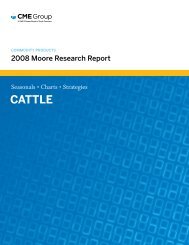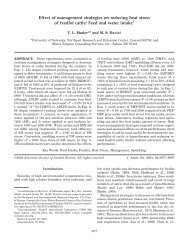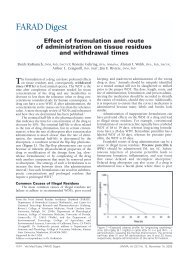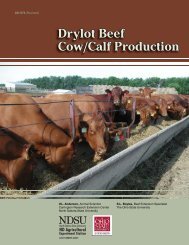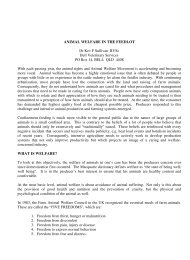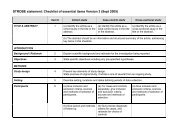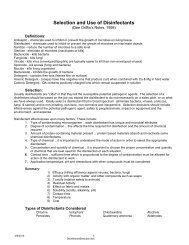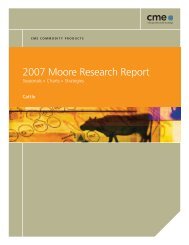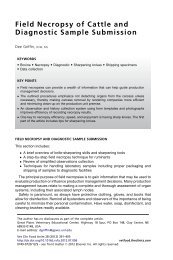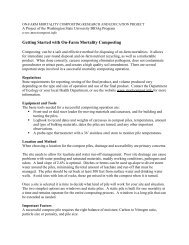CRIMES WITHOUT CONSEQUENCES - gpvec
CRIMES WITHOUT CONSEQUENCES - gpvec
CRIMES WITHOUT CONSEQUENCES - gpvec
Create successful ePaper yourself
Turn your PDF publications into a flip-book with our unique Google optimized e-Paper software.
7.2 Methods allowed<br />
Crimes Without ConsequenCes<br />
Neither the Humane Methods of Slaughter Act, nor the regulations under the law,<br />
specifically prohibits the use of a sledgehammer or ax to stun an animal for slaughter. As<br />
a result, when animal advocates worked with state legislators during the 1960s and 1970s<br />
to pass statewide prohibitions on inhumane slaughter methods, use of these implements<br />
was often included. 196 Connecticut law, for example, provides that “Use of a manuallyoperated<br />
sledge, hammer or poleax to render an animal insensible to pain is prohibited.”<br />
However, although federal law does not prohibit use of a hammer or ax, the USDA-FSIS<br />
does not consider these to be acceptable mechanical means of stunning. 197<br />
7.3 Exemptions<br />
The Federal Humane Methods of Slaughter Act identifies slaughtering in accordance<br />
with ritual requirements of the Jewish or other religious faith as humane. Moreover, the<br />
law spells out that not only slaughter, but “the handling or other preparation of livestock<br />
for ritual slaughter are exempted” from the Act. 198 All states with humane slaughter laws<br />
have included a similar exemption for religious slaughter. However, while the federal law<br />
includes language that covers handling, state laws typically refer to slaughter only.<br />
A few states have attempted to encourage, if not require, the use of holding pens for<br />
religious slaughter in order to avoid shackling and hoisting of conscious animals.<br />
Connecticut was the first state to require use of holding pens that allow animals not<br />
previously stunned to be cut while upright. However, a general exception to the law for<br />
religious slaughter makes use of the pens voluntary under Connecticut’s law. 199<br />
Section 22-272a. Approved methods of slaughter<br />
(b)(2) restraint of the animal by means of a pen approved by the commissioner which<br />
firmly encloses the animal and, with a minimum of excitement and discomfort, places<br />
the animal in such a position that a cutting stroke may be administered quickly and<br />
efficiently; (3) restraint of the animal by means of a body harness approved by the<br />
commissioner which lifts, supports and cradles the animal and, with a minimum of<br />
excitement and discomfort, places it in such a position that a cutting stroke may be<br />
administered quickly and efficiently, and (4) restraint of the animal by any other means<br />
approved by the commissioner which causes the animal no unreasonable or unnecessary<br />
pain and which, with a minimum of excitement and discomfort, places the animal in such<br />
a position that a cutting stroke may be administered quickly and efficiently.<br />
196 Use of a hammer or ax to stun an animal is prohibited under the laws of Colorado, Connecticut, Illinois,<br />
Indiana, Kansas, Maryland, Massachusetts, Michigan, Minnesota, Pennsylvania, Rhode Island, Vermont and<br />
Washington.<br />
197 USDA-FSIS, Human Resources Development Staff, For the welfare of livestock (interactive CD training<br />
guide), July 1998.<br />
198 7 U.S.C. Section 1906.<br />
199 Section 22-272(e).<br />
66




